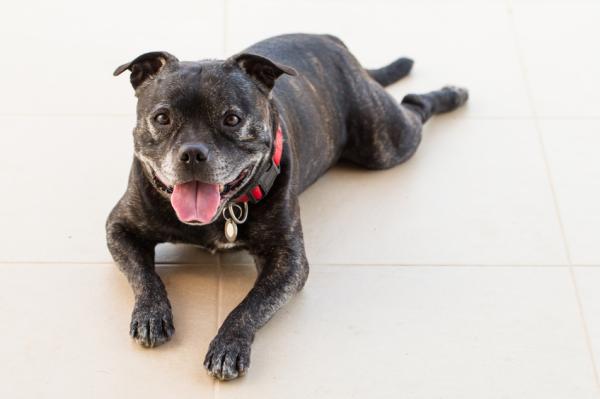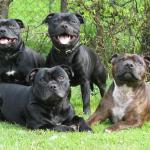Staffordshire Bull Terrier

The Staffordshire Bull Terrier is a cheerful and positive dog. They're perfect for active and dynamic people. It is very important that you previously inform yourself about their education, care and needs if you are thinking of adopting a dog with these characteristics.
In this AnimalWised breed sheet, we will explain everything you need to know about the Staffordshire Bull Terrier. Informing oneself before the adoption leads to a thoughtful, responsible and successful adoption. This way, you'll be able to help them remain a happy dog for many years.
- Europe
- United Kingdom
- Group III
- 5-14
- 14-18
- 18-22
- 22-27
- 27-31
- More than 31
- 2-7
- 7-22
- 22-55
- 55-100
- 100-220
- 8-10
- 10-12
- 12-14
- 15-20
- Low
- Meidum
- High
Origin
The history of the Staffordshire Bull Terrier is closely linked to the history of the pit bull terrier and other bull terrier breeds. The Staffordshire Bull Terrier derives from the extinct British bull and terrier. These dogs were used for dog fighting until that deplorable activity was banned. The Staffordshire Bull Terrier is currently recognized by canine societies around the world. Nowadays, many Staffordshire Bull Terrier participate in dog sports such as agility and competitive obedience.
Physical Appearance
The Staffordshire is a muscular, medium-sized dog with short hair. Although they are a robust and powerful dog for their size, they are also an agile and active dog. Their short and wide head can frighten those who do not know them. Their bulky cheeks demonstrate how developed their chewing muscles are. Their nose is black in all varieties of the breed.
The Staffordshire's eyes are medium and round. Dark eyes are common but it can change depending on the color of each dog's coat. The ears are shaped like a rose pedal or are semi-straight. They should not be large or heavy. Their neck is short and muscular, and their upper body line is leveled. Their lower back is short and muscular. The Staffordshire Bull Terrier's chest is wide, deep and muscular, with well-arched ribs.
Their tail is thick at the base and thins towards its end. It has a low insertion and should not curl up. The short and straight hair of the Staffordshire Bull Terrier can be of different colors:
- Red
- Tawny
- White
- Black
- Brindle
It can also be any of these colors combined with white.
Generally, the height at the withers is between 14 to 16 centimeters. In the breed standards males should weigh between 28 to 37 lbs, while females should weigh between 24 to 34 lbs.
Character
The Staffordshire Bull Terrier is an excellent dog, perfect for active families. He is usually very friendly with people and even more with children, whom he loves and protects. Among all dog breeds, this is the only one whose standard indicates that they are “completely reliable”. Of course, that does not mean that all Staffordshire are like this, but it does mean that reliability is one of their innate characteristics. They are also very friendly, happy and sweet dogs.
With an appropriate education, which we will talk about next, the Staffordshire Bull Terrier becomes an excellent and very sociable dog. They usually relate wonderfully with other dogs, without any problem. They love to play, exercise and have new experiences. In addition, the positive personality that the Staffordshire Bull Terrier possesses will last for many years. Even in old age they will be a lovely and cheerful dog, always willing to show their love to their family.
Care
It is very important to keep in mind that the Staffordshire Bull Terrier is a dog that needs to exercise a lot. In addition to physical exercise, we can also include day-to-day intelligence games that allow them to develop their different senses and feel mentally active. Other activities that can meet their high energetic level are:
- Canine sports
- Jogging
- Mountain excursions
- Ball games
- Intelligence games
In addition to these activities, Staffordshire Bull Terriers must enjoy at least two or three relaxed walks a day.
The Staffordshire Bull Terrier's fur is very easy to care for and maintain. Having such a short coat, a weekly brushing and a bath every 1-2 months will be enough to maintain a shiny coat. To brush them, a rubber mitten is recommended to remove dirt and dead hairs.
Education and Training
A Staffordshire Bull Terrier's education and training must be based entirely on positive reinforcement. Although they are intelligent dogs and will respond well, it may take a while for them to correctly relate our indications to what they are learning. We must be patient when teaching them, especially when they are a puppy.
To begin their education, we can start by socializing them with other animals, people and environments when they are a puppy. Once the veterinarian tells us they are ready to be taken out on a walk, we will start to incorporate this new activity to their everyday life. The puppy will start to learn about this new environment where they encounter new things such as bicycles, people and other animals. Positive encouragement and making sure that the puppy has good interactions will help them not suffer fears or develop behavioral issues.
Growing up, we can incorporate other activities previously mentioned, such as intelligence games. Another great idea is to teach them basic obedience orders such as sitting, coming, staying, etc. This will help us ensure their safety in new situations and encourage our communication with them. In their adult stage, we should continue to socialize them so that they remain a sociable dog that enjoys a complete life with other dogs.
Health Care
The Staffordshire Bull Terriers are relatively healthy dogs. As any other dog breed they are more susceptible to genetic and hereditary problems. For that reason it is fundamental that the dog is brought to the veterinarian every 6 months for a check up. This will ensure us that our Staffordshire is healthy and perhaps detect any health problem that may arise. Some of the most common diseases that the Staffordshire Bull Terrier usually suffer from are:
- Waterfalls
- Heatstroke
- Respiratory problems
- Hip dysplasia
Do not forget that in addition to visiting the veterinarian it will be essential to strictly follow the vaccination schedule. This will help prevent your dog from serious contagious diseases. Deworming them on a regular basis is also very important: externally every 1 month and internally every 3 months.
Vídeo de Staffordshire Bull Terrier
Staffordshire Bull Terrier photos























